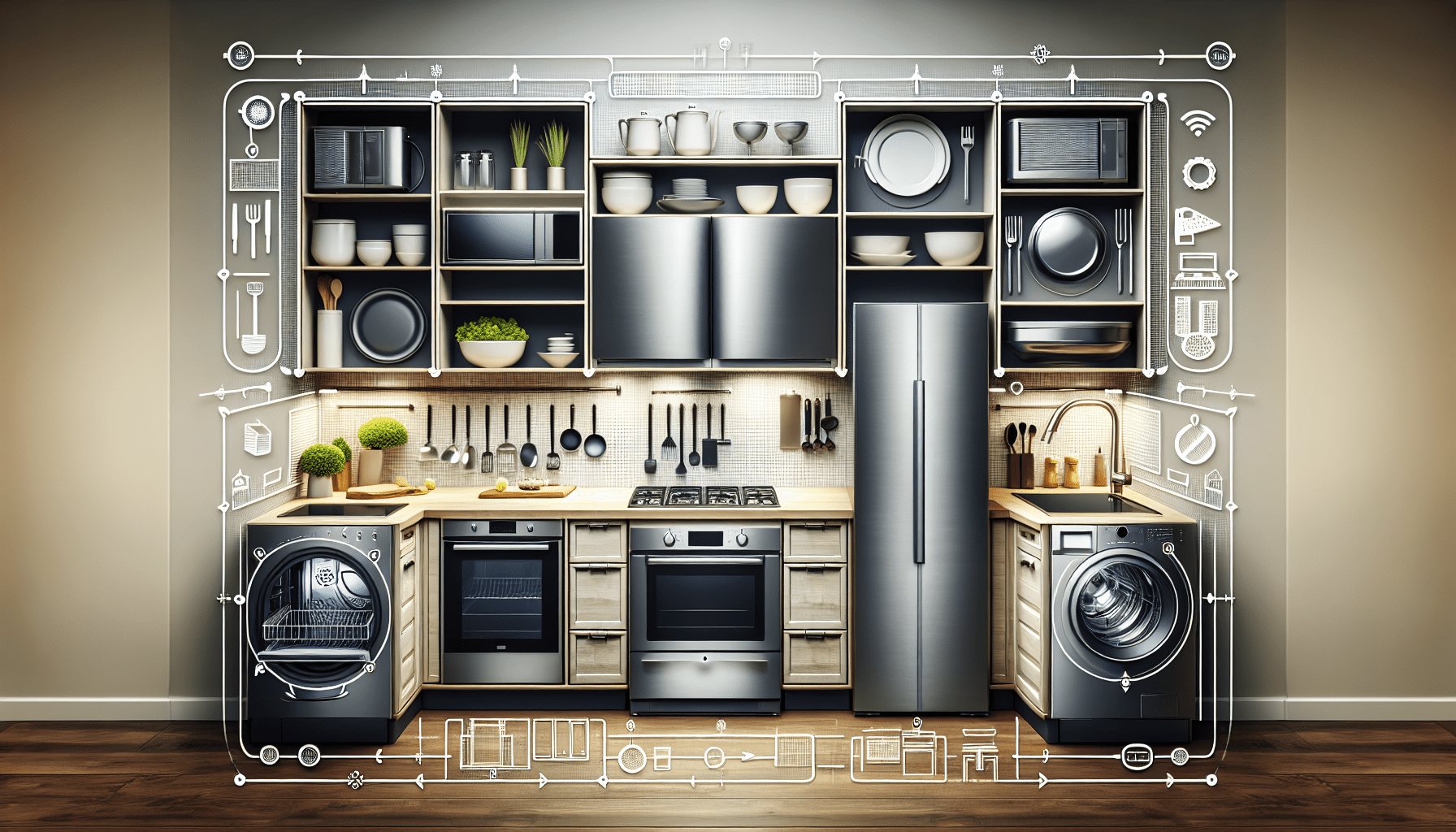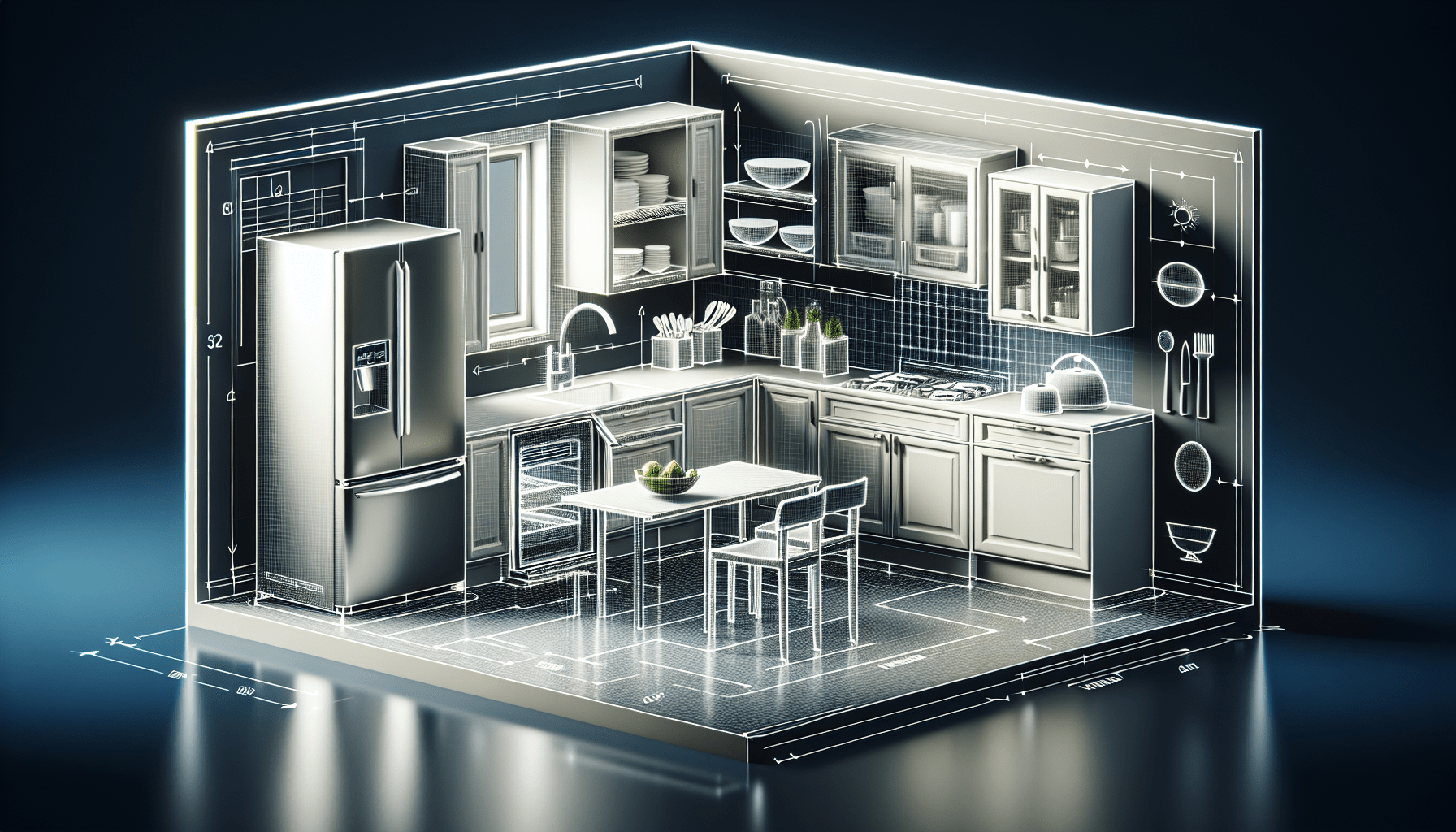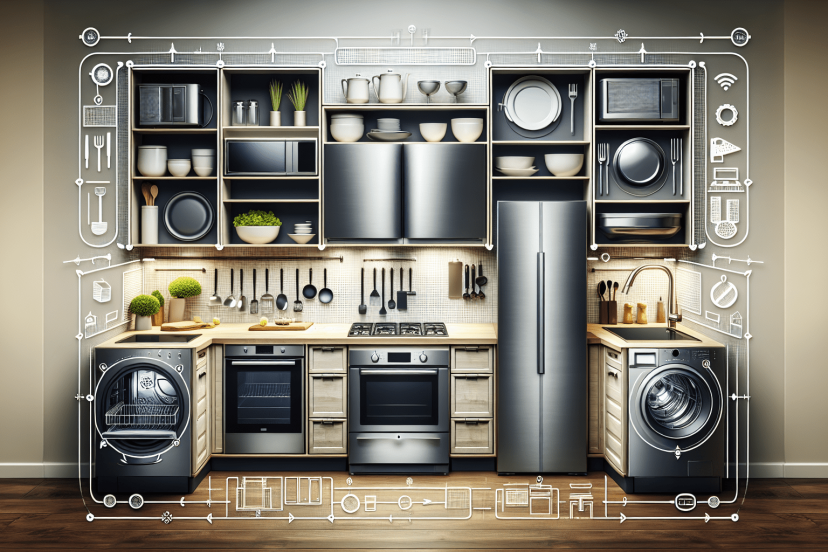Where Should Appliances Be Placed In A Kitchen?
When it comes to designing your dream kitchen, one important aspect to consider is the placement of your appliances. From the refrigerator to the oven, each appliance plays a crucial role in the functionality and flow of your culinary haven. But, where should these appliances be placed for maximum efficiency and convenience? In this article, we’ll explore some practical tips and guidelines to help you make informed decisions on where to position your appliances in your kitchen. So, let’s get started and create a kitchen that not only looks great but also works seamlessly for you!
Sink and Dishwasher
Placement near each other for convenient workflow
When designing your kitchen layout, it is important to consider the placement of the sink and dishwasher. These two essential elements should be positioned near each other to enhance workflow and make your kitchen tasks more efficient. By having the sink and dishwasher in close proximity, you can easily rinse and clean dirty dishes before loading them into the dishwasher. This not only saves time but also reduces the chances of water dripping on the floor while carrying dishes from the sink to the dishwasher.
Consider placing near a window for natural light
Another factor to take into account when determining the location of your sink and dishwasher is natural light. If possible, try to position them near a window to maximize the amount of daylight that illuminates your workspace. Natural light not only provides a pleasant ambiance but also helps in identifying any spots or stains that may be missed under artificial lighting. Additionally, having a view of the outdoors while you work at the sink can be refreshing and make your kitchen experience more enjoyable.
Ensure proper drainage for the dishwasher
One crucial consideration when installing a dishwasher is ensuring proper drainage. The location of the dishwasher must be chosen carefully to allow for effective drainage without any potential blockages. When the dishwasher is installed, it should be positioned in close proximity to a drainage pipe or a dedicated plumbing line. This will ensure a smooth and efficient flow of water from your dishwasher, preventing any issues with standing water or unpleasant odors. Proper drainage is essential for maintaining the cleanliness and functionality of your dishwasher, so it should not be overlooked in the planning process.
Refrigerator
Place away from oven or direct sunlight to maintain temperature
The placement of your refrigerator is of utmost importance to maintain its optimal temperature and efficiency. It is advisable to position the refrigerator away from the oven or any other heat-producing appliances in your kitchen. High levels of heat can negatively affect the refrigerator’s cooling system, making it work harder to maintain the desired temperature. By keeping the refrigerator away from direct sunlight and heat sources, you can ensure its longevity and energy efficiency.
Ensure easy access for both cooking and storage needs
Consider the practicality of accessing your refrigerator for both cooking and storage purposes. Ideally, it should be placed within easy reach of your cooking area, allowing you to retrieve ingredients quickly and efficiently while preparing meals. Moreover, easy access to the refrigerator while cooking enables you to check ingredient availability and store perishable items promptly, preventing food spoilage. By strategically placing the refrigerator near your primary workspace, you can streamline your culinary endeavors and enhance your overall kitchen experience.
Consider proximity to dining area for convenience
If your kitchen layout includes a dining area or breakfast nook, it is worth considering the proximity of your refrigerator to this space. Placing the refrigerator close to your dining area allows for easy access to beverages, condiments, and other items you may need during meals. This arrangement eliminates unnecessary trips across the kitchen, enhancing the convenience and efficiency of your mealtime routine. Additionally, having the refrigerator nearby while entertaining guests can make it more convenient to serve drinks or retrieve additional items if needed.

Oven and Stove
Place near countertop space for food preparation and serving
When determining the location for your oven and stove, it is essential to consider the availability of countertop space. By placing them near a countertop, you create a seamless flow between your cooking and food preparation areas. This allows you to easily transfer ingredients from the countertop to the stove and oven, minimizing unnecessary movements and maximizing efficiency in your cooking process. Additionally, having the oven and stove in close proximity to the countertop provides a convenient surface for plating and serving dishes hot out of the oven.
Provide adequate ventilation for cooking odors and heat
Proper ventilation is crucial when it comes to the placement of your oven and stove. A well-ventilated kitchen helps to dissipate cooking odors, steam, and heat, creating a comfortable environment while preventing the accumulation of excess moisture. When installing your oven and stove, consider positioning them near a window or ensuring there is an efficient exhaust system in place. This ensures that any fumes or heat generated during cooking are effectively removed from the kitchen, improving air quality and maintaining a pleasant atmosphere.
Consider placing away from high-traffic areas to avoid accidents
Safety should always be a top priority in kitchen design, especially when it comes to the placement of appliances like ovens and stoves. To minimize the risk of accidents, it is advisable to position these appliances away from high-traffic areas. By keeping them away from thoroughfares and busy sections of your kitchen, you can reduce the likelihood of accidental bumps or collisions while cooking. This placement also allows for a dedicated cooking zone, providing a designated space for culinary activities and enhancing overall kitchen organization.
Microwave
Choose a convenient height for easy access
Selecting the right height for your microwave is essential for ease of use and accessibility. The ideal placement of the microwave should be at a height that allows you to comfortably reach inside and see the contents without having to strain or bend over. By placing it at a convenient height, you can prevent any unnecessary physical strain while using the microwave, ensuring a more ergonomic and enjoyable cooking experience.
Consider placing near the stove for reheating purposes
To optimize the functionality of your kitchen, consider placing the microwave near the stove. This placement is particularly beneficial when it comes to reheating dishes. By situating the microwave close to the stove, you can easily transfer food from one appliance to the other, making the process of reheating meals more seamless. This arrangement also helps to create a dedicated cooking zone in your kitchen, allowing you to efficiently navigate between different cooking tasks.
Ensure proper ventilation and space for heat dissipation
When installing a microwave, it is crucial to prioritize proper ventilation and allow sufficient space for heat dissipation. Microwaves generate heat during operation, and ensuring adequate ventilation prevents overheating and potential damage to the appliance. Make sure there is enough clearance around the microwave to allow air to circulate effectively, preventing the buildup of heat. Additionally, proper ventilation reduces the impact of cooking odors and steam, helping to maintain a clean and fresh kitchen environment.

Coffee Maker
Place near a water source for easy refilling
When deciding on the location for your coffee maker, it is beneficial to position it near a water source for easy refilling. This allows you to conveniently add water without having to carry it from another area of the kitchen. Ideally, place the coffee maker near the sink to minimize the distance you need to travel when refilling the water reservoir. This placement ensures that you can enjoy a fresh cup of coffee without any unnecessary inconvenience or delays.
Consider proximity to a seating area for morning convenience
If you have a seating area in your kitchen, it is worth considering the proximity of your coffee maker to this space. Placing the coffee maker near your seating area creates a convenient and efficient morning routine. You can brew your coffee while still enjoying the comfort of your seating area, allowing you to begin your day with ease and relaxation. This arrangement eliminates the need to travel across the kitchen early in the morning, ensuring a delightful and efficient start to your day.
Ensure proper ventilation to prevent heat buildup
Coffee makers generate heat during the brewing process, and it is essential to ensure proper ventilation to prevent heat buildup. When selecting the location for your coffee maker, make sure it is not placed in an enclosed area or close to flammable materials. Adequate ventilation allows heat to dissipate, ensuring the longevity and safety of the appliance. By considering proper ventilation, you can enjoy your daily cup of coffee without any worries concerning heat-related issues.
Toaster/Toaster Oven
Ensure adequate counter space for safe usage
When positioning your toaster or toaster oven, it is crucial to ensure that you have adequate counter space. These appliances need sufficient room for safe usage, including the placement of bread or other food items and the removal of hot items once they are toasted. Therefore, it is essential to allocate an appropriate amount of counter space in close proximity to the toaster or toaster oven. This ensures convenience, safety, and efficient utilization of these appliances.
Place away from cabinets or curtains to prevent fire hazards
Toaster ovens and toasters can generate substantial heat, and it is important to position them away from potential fire hazards. Avoid placing them near cabinets, curtains, or other flammable materials that could potentially catch fire when exposed to heat. By ensuring a safe distance from such items, you can eliminate the risk of accidental fires and ensure the overall safety of your kitchen. Prevention is always key when it comes to fire hazards, so careful placement of your toaster or toaster oven is crucial.
Consider proximity to dining area for easy access to toasted items
If your kitchen includes a dining area, consider the proximity of your toaster or toaster oven to enhance convenience and accessibility during mealtime. Placing the toaster or toaster oven near your dining area allows you to easily access and serve freshly toasted items, such as bread or bagels, to your family or guests. This arrangement reduces the need to carry hot items across the kitchen, ensuring that everyone can enjoy warm and delicious breakfast or snack options effortlessly.
Dish Storage
Place near the sink and dishwasher for efficient cleanup
Efficient kitchen design involves placing dish storage near the sink and dishwasher. This ensures that once your dishes are clean, they can be easily placed back into their designated storage area without taking unnecessary steps. Placing dish storage in close proximity to the sink and dishwasher streamlines the process of cleanup, allowing you to smoothly transition from washing to drying and storage with minimal effort. By considering convenience during the planning stage, you can optimize the efficiency of your kitchen workflow.
Consider accessibility while cooking for easy retrieval
When organizing your dish storage, it is important to consider accessibility while cooking. You should be able to effortlessly retrieve the necessary dishes, utensils, and cookware during the meal preparation process. By positioning the dish storage in close proximity to your primary cooking area, you can quickly obtain items when needed. This arrangement minimizes time spent searching for the right cookware or dishes, allowing you to focus on creating delicious meals without interruptions or frustrations.
Ensure enough storage to accommodate all types of dishes
A well-organized kitchen requires sufficient storage space to accommodate all types of dishes and utensils. When planning your dish storage, ensure that you have enough cabinets or shelves to hold your plates, bowls, glasses, mugs, and other items. Consider adjustable shelving or custom storage solutions to maximize space utilization and adapt to different dish sizes. Sufficient dish storage prevents clutter and maintains an organized kitchen, making it easy to find and access items efficiently.
Food Storage
Designate a pantry area for dry goods and non-perishables
An essential aspect of kitchen organization is having a designated pantry area for dry goods and non-perishable items. When determining the location for your pantry, choose a space that is easily accessible and can accommodate various storage solutions, such as shelves or cabinets. A well-organized pantry allows you to stock up on essential ingredients and supplies, keeping your kitchen well-stocked and ready for any culinary adventure. Whether it’s spices, canned goods, or baking supplies, a designated pantry area ensures that everything is easily accessible and neatly organized.
Place refrigerator and freezer nearby for convenience
To enhance convenience and efficiency in your kitchen, it is advisable to place your pantry area near the refrigerator and freezer. This arrangement allows for easy transfer of perishable items or ingredients that require refrigeration or freezing. By positioning the refrigerator and freezer in close proximity to your pantry, you can quickly store groceries or retrieve items for meal preparation. This minimizes unnecessary travel across the kitchen and ensures that your perishable items remain fresh and safely stored at all times.
Consider temperature and humidity control for food preservation
When deciding on the location for your food storage areas, it is crucial to consider temperature and humidity control. Food preservation relies on maintaining optimal conditions to prevent spoilage or degradation. Avoid placing your pantry, refrigerator, or freezer near heat sources, direct sunlight, or areas with excessive moisture. These factors can negatively impact the quality and longevity of your stored food items. By placing your food storage areas in a controlled environment, you can ensure that your groceries remain fresh and safe for consumption.
Trash and Recycling
Place near food prep and cleanup areas for easy disposal
Convenience is key when it comes to the placement of your trash and recycling bins. To streamline your food preparation and cleanup process, position your trash and recycling containers near areas where you generate the most waste. Placing them near your food prep area and sink ensures that you can easily dispose of scraps, packaging, and other waste without having to travel across the kitchen. This placement minimizes the chances of a mess and promotes a more efficient and hygienic kitchen environment.
Ensure sufficient space for both trash and recycling bins
When determining the location for your trash and recycling bins, ensure that you have enough space to accommodate both. It is important to allocate sufficient room for separate bins to facilitate efficient waste management. Consider using larger bins or separate compartments within a single unit to effectively sort and store recyclables. Adequate space for both trash and recycling bins promotes responsible waste disposal, making it easier to maintain a clean and organized kitchen area.
Consider storage solutions to minimize odors and pests
To prevent unpleasant odors and discourage pests, consider storage solutions for your trash and recycling bins. Opt for bins with a secure lid to trap odors and minimize their spread throughout your kitchen. Additionally, choose containers that are easy to clean and sanitize to maintain a hygienic environment. If space allows, consider integrating a dedicated cabinet or pull-out drawer to hide and contain the bins, further reducing the chances of odor or pest issues. By implementing appropriate storage solutions, you can ensure cleanliness and create a more pleasant kitchen environment.
Small Appliances
Determine frequency of use for proper placement
Small appliances such as blenders, food processors, and mixers can take up valuable counter space. To optimize your kitchen layout, consider the frequency of use for each appliance. Items that are used daily or regularly should be given priority placement on the countertop for easy access. Less frequently used appliances can be stored in cabinets or designated storage areas to free up valuable workspace. By strategically placing your small appliances, you can maximize efficiency and minimize clutter in your kitchen.
Consider counter space availability and proximity to outlets
When determining the placement of small appliances, take into account the availability of counter space and proximity to electrical outlets. It is essential to have ample space on your countertop for safe and convenient usage of appliances. Consider the size and shape of each appliance to ensure that it fits comfortably on the countertop without obstructing other areas or appliances. Additionally, make sure that the appliances can be easily plugged into nearby outlets to avoid excessive use of extension cords or inconveniently placed wiring.
Ensure easy access and storage solutions for each appliance
To promote convenience and maintain a tidy kitchen, it is essential to ensure easy access and storage solutions for each small appliance. Consider allocating specific storage areas or cabinets for each appliance, keeping them organized and readily accessible. This approach allows you to quickly locate and retrieve the desired appliance while minimizing clutter on the countertop. By providing dedicated storage solutions for your small appliances, you can optimize your kitchen’s functionality and maintain a clean and inviting space.
In conclusion, the placement of appliances in your kitchen plays a significant role in optimizing functionality, efficiency, and overall satisfaction with your cooking space. Strategic placement of essential elements such as the sink, dishwasher, refrigerator, oven, stove, microwave, coffee maker, toaster/toaster oven, dish storage, food storage, trash and recycling bins, and small appliances can greatly enhance your kitchen experience. By considering factors such as convenience, accessibility, proper ventilation, safety, and storage solutions, you can create a well-organized and efficient kitchen layout tailored to your individual needs.




